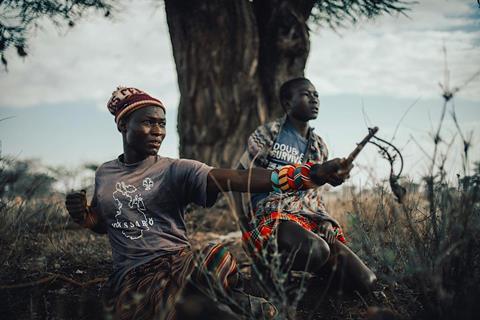Immersive prize-winning doc charts the impact of climate change on the Turkana community of Eastern Kenya

Dirs: Andrew H Brown, Moses Thuranira. Kenya. 2023. 82mins
Isiolo County, in Eastern Kenya, is a place of stunning natural beauty and ugly economic poverty. Despite being developed for tourism as part of the Kenya Vision 2030 programme, launched in 2008 by then President Mwai Kibaki, the region’s indigenous people still live a precarious existence on the land. That is becoming increasingly difficult, thanks to a changing climate which intensifies pressure on natural resources and exacerbates tensions between the villages that rely on them. Through its focus on one young member of the nomadic Turkana community, this sharp documentary makes clear the personal cost of this global issue through lived experience.
A cinematic, rather than didactic, approach to the problem of climate change
As opening titles explain, Between The Rains has been made with “the blessings and creative collaboration of The Elders and Families of Ngaremara Village”, and also has two lead producers, Samuel Ekomol and Moses Thuranira (who also co-directs), who were born and raised in Isiolo County. This lends the project an authenticity that should help it connect with audiences, and its Best Documentary and Best Cinematography wins at Tribeca will help it travel following an international premiere at Sheffield DocFest. Specialist distributors may also be tempted by its big-screen worthy craft and cinematic, rather than didactic, approach to the problem of climate change.
Having lived in the area for over 28,000 years, the Turkana understandably view things through a traditional lens that favours tradition over science. Aware that their environment is changing — the droughts last longer, the sun beats hotter — the Ngaremara village elders take an introspective stance, examining their own relationship with the world around them. Their belief is that settling down in one place, rather than following the rains as they used to, has put too much of a burden on the land, angering Akuj, the spirit of nature. “Nature is the only power that can destroy us,” determines an elder in a defiant opening voice over.
Filming over four years from 2018 to 2022, co-directors Thuranira and Andrew H. Brown (who produced 2018 Kenya poaching documentary When Lambs Become Lions) sensitively document just how close the Turkana are to destruction. (Closing titles present the sobering fact that they are on course for cultural extinction within 20 years). Editors Brown, Charity Kuria and Dedan Wangui have astutely distilled down this mass of footage to focus on the uncertain future of Kole, a young Turkana shepherd who is expected to follow in his older brother Patrick’s footsteps and become a warrior. Kole, however, is exhausted by the challenges of tending to his flock — pasture is hard to find, hungry hyenas are a constant threat — and dreams of more. Spotting an aeroplane in the sky, he sketches a cityscape of gleaming towers.
It’s clear, too, that Kole doesn’t naturally conform to the community’s traditional notions of manhood. His dying grandmother tells him to “be a man” and stop fussing over her. His brother regularly admonishes him for his supposed weakness, particularly when he dares shed a tear. When he begs the elders to stop a traditional ceremony, which involves them forcibly removing two of his teeth in order to prove his bravery, he is branded a coward. This type of ferocious masculinity could easily be described as toxic, but that would arguably be grafting a modern Western viewpoint onto this ancient culture — something this respectful film is careful not to do.
Instead, it follows Kole with patience, giving him the time and space to author his own story. His feelings of isolation intensify as the Turkana embark on a collision course with their neighbours, the Samburu (the community from which co-director/producer Thuranira hails). With natural resources dwindling, and despite pleas for peace from some in the communities, the battle for survival becomes increasingly violent — and Kole feels compelled to prove his worth.
Expressive cinematography from Brown juxtaposes the picture-postcard Kenyan landscape — trees silhouetted against purple skies, birds chattering in branches — with more intimate close-ups of the harsh realities of daily life. Dust swirls in mini tornadoes, riverbeds dry and crack, while elders attempt to read the future in the intestines of slaughtered cattle. “The rains will return if we remember our traditions,” asserts the Shaman, digging through the entrails. And while the film ends with that long-awaited deluge, there can be no guarantee that Akuj will be so easily appeased.
Production company: Ragtag Collective
International sales: Journeyman sales@journeyman.tv
Producers: Andrew H. Brown, Samuel Ekomol, Isaac Gem, Naomi Lapana, Moses Thuranira
Cinematography: Andrew H. Brown
Editing: Andrew H. Brown, Charity Kuria, Dedan Wangui
Music: Kevin Matley







![The Brightest SunScreen[Courtesy HKIFF]](https://d1nslcd7m2225b.cloudfront.net/Pictures/274x183/3/5/0/1448350_thebrightestsunscreencourtesyhkiff_312678.jpg)























